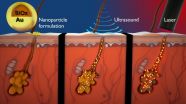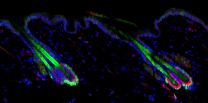Altering brain chemistry makes us more sensitive to inequality
Study finds that prolonging dopamine's effects in the brain boosts compassion
2015-03-19
(Press-News.org) What if there were a pill that made you more compassionate and more likely to give spare change to someone less fortunate? UC Berkeley scientists have taken a big step in that direction.
A new study by UC Berkeley and UC San Francisco researchers finds that giving a drug that changes the neurochemical balance in the prefrontal cortex of the brain causes a greater willingness to engage in prosocial behaviors, such as ensuring that resources are divided more equally.
The researchers also say that future research may lead to a better understanding of the interaction between altered dopamine-brain mechanisms and mental illnesses, such as schizophrenia or addiction, and potentially light the way to possible diagnostic tools or treatments for these disorders.
"Our study shows how studying basic scientific questions about human nature can, in fact, provide important insights into diagnosis and treatment of social dysfunctions," said Ming Hsu, a co-principal investigator and assistant professor at UC Berkeley's Haas School of Business.
"Our hope is that medications targeting social function may someday be used to treat these disabling conditions," said Andrew Kayser, a co-principal investigator on the study, an assistant professor of neurology at UC San Francisco and a researcher in the Helen Wills Neuroscience Institute at UC Berkeley.
In the study, published online today (March 19) in the journal Current Biology, participants on two separate visits received a pill containing either a placebo or tolcapone, a drug that prolongs the effects of dopamine, a brain chemical associated with reward and motivation in the prefrontal cortex. Participants then played a simple economic game in which they divided money between themselves and an anonymous recipient. After receiving tolcapone, participants divided the money with the strangers in a fairer, more egalitarian way than after receiving the placebo.
"We typically think of fair-mindedness as a stable characteristic, part of one's personality," said Hsu. "Our study doesn't reject this notion, but it does show how that trait can be systematically affected by targeting specific neurochemical pathways in the human brain."
In this double-blind study of 35 participants, including 18 women, neither participants nor study staff members knew which pills contained the placebo or tolcapone, an FDA-approved drug used to treat people with Parkinson's disease, a progressive neurological disorder affecting movement and muscle control.
Computational modeling showed Hsu and his colleagues that under tolcapone's influence, game players were more sensitive to and less tolerant of social inequity, the perceived relative economic gap between a study participant and a stranger.
By connecting to previous studies showing that economic inequity is evaluated in the prefrontal cortex, a core area of the brain that dopamine affects, this study brings researchers closer to pinpointing how prosocial behaviors such as fairness are initiated in the brain.
"We have taken an important step toward learning how our aversion to inequity is influenced by our brain chemistry," said the study's first author, Ignacio Sáez, a postdoctoral researcher at the Haas School of Business. "Studies in the past decade have shed light on the neural circuits that govern how we behave in social situations. What we show here is one brain 'switch' we can affect."
INFORMATION:
In addition to Hsu, Sáez, and Kayser, co-authors include Eric Set of UC Berkeley and Lusha Zhu of the Virginia Tech Carilion Research Institute. The study was funded by grants from the Department of Defense, Institute for Molecular Neuroscience, National Institutes of Health and Hellman Family Faculty Fund.
ELSE PRESS RELEASES FROM THIS DATE:
2015-03-19
URBANA, Ill. - Over the last several decades there have been substantial yield improvements in soybean. Because of new varieties and new agronomic practices, the yield potential in soybean is higher now than ever before. But a lack of updated information on the nutritional needs of soybean crops may be limiting the crop's potential.
Researchers from the University of Illinois Crop Physiology Laboratory led by Fred Below have recently provided an updated set of nutrition needs for soybean, identifying exactly which nutrients the plant needs, when those nutrients are accumulated ...
2015-03-19
Acne, a scourge of adolescence, may be about to meet its ultra high-tech match. By using a combination of ultrasound, gold-covered particles and lasers, researchers from UC Santa Barbara and the private medical device company Sebacia have developed a targeted therapy that could potentially lessen the frequency and intensity of breakouts, relieving acne sufferers the discomfort and stress of dealing with severe and recurring pimples.
"Through this unique collaboration, we have essentially established the foundation of a novel therapy," said Samir Mitragotri, professor ...
2015-03-19
Our eyes are drawn to several dimensions of an object--such as color, texture, and luminance--even when we need to focus on only one of them, researchers at New York University and the University of Pennsylvania have found. The study, which appears in the journal Current Biology, points to the ability of our visual system to integrate multiple components of an item while underscoring the difficulty we have in focusing on a particular aspect of it.
"Even when we want and need to focus on one dimension of things we come across every day, such as the texture of your cat's ...
2015-03-19
For in vitro fertilization and other assisted reproductive technologies, selecting the healthiest and best swimming sperm from a sample of semen can dramatically increase success. Microfluidics--micro-scale technologies that were originally developed to enable high-throughput gene sequencing and for Point-Of-Care diagnostics--are now being adapted to enhance sperm sorting. These new methods, reviewed by engineers in the journal Trends in Biotechnology, are generating promising results in applications such as single-sperm genomics, in-home male fertility testing, and wildlife ...
2015-03-19
A combination of human stem cell transplantation and antidiabetic drugs proved to be highly effective at improving body weight and glucose metabolism in a mouse model of type 2 diabetes. The findings, published March 19th by Stem Cell Reports, could set the stage for clinical trials to test the first stem cell-based approach for insulin replacement in patients with type 2 diabetes.
Type 2 diabetes, which accounts for 90%-95% of the now approaching 400 million cases of diabetes worldwide, is currently treated by oral medication, insulin injections, or both to control blood ...
2015-03-19
Altered signaling through the vitamin D receptor on certain immune cells may play a role in causing the chronic inflammation that leads to cardiometabolic disease, the combination of type 2 diabetes and heart disease that is the most common cause of illness and death in Western populations. The research appears March 19 in the journal Cell Reports.
"Because low vitamin D levels are associated with diabetes and heart disease, we looked at the connections between vitamin D, immune function, and these disease states," says senior author Carlos Bernal-Mizrachi, of the Washington ...
2015-03-19
Scientists at the University of British Columbia and BetaLogics, part of Janssen Research & Development, LLC have shown for the first time that Type 2 diabetes can be effectively treated with a combination of specially-cultured stem cells and conventional diabetes drugs.
Stem cells - generic cells that haven't yet taken on specialized form and function - have recently been used by scientists at UBC and elsewhere to reverse Type 1 diabetes in mice. In Type 1 diabetes, which usually begins in childhood, the pancreas produces little or no insulin, the hormone that enables ...
2015-03-19
A research team at UC San Francisco has discovered an RNA molecule called Pnky that can be manipulated to increase the production of neurons from neural stem cells.
The research, led by neurosurgeon Daniel A. Lim, MD, PhD, and published on March 19, 2015 in Cell Stem Cell, has possible applications in regenerative medicine, including treatments of such disorders as Alzheimer's disease, Parkinson's disease and traumatic brain injury, and in cancer treatment.
Pnky is one of a number of newly discovered long noncoding RNAs (lncRNAs), which are stretches of 200 or more ...
2015-03-19
A new study has shown that the dottyback, a small predatory reef fish, can change the colour of its body to imitate a variety of other reef fish species, allowing the dottyback to sneak up undetected and eat their young.
The dottyback also uses its colour-changing abilities to hide from larger predators by colour-matching to the background of its habitat - disappearing into the scenery.
The research, published today in the journal Current Biology, reveals a sophisticated new example of 'mimicry': disguising as a different species to gain evolutionary advantage. ...
2015-03-19
Stem cells can have a strong sense of identity. Taken out of their home in the hair follicle, for example, and grown in culture, these cells remain true to themselves. After waiting in limbo, these cultured cells become capable of regenerating follicles and other skin structures once transplanted back into skin. It's not clear just how these stem cells -- and others elsewhere in the body -- retain their ability to produce new tissue and heal wounds, even under extraordinary conditions.
New research at Rockefeller University has identified a protein, Sox9, that takes the ...
LAST 30 PRESS RELEASES:
[Press-News.org] Altering brain chemistry makes us more sensitive to inequality
Study finds that prolonging dopamine's effects in the brain boosts compassion




